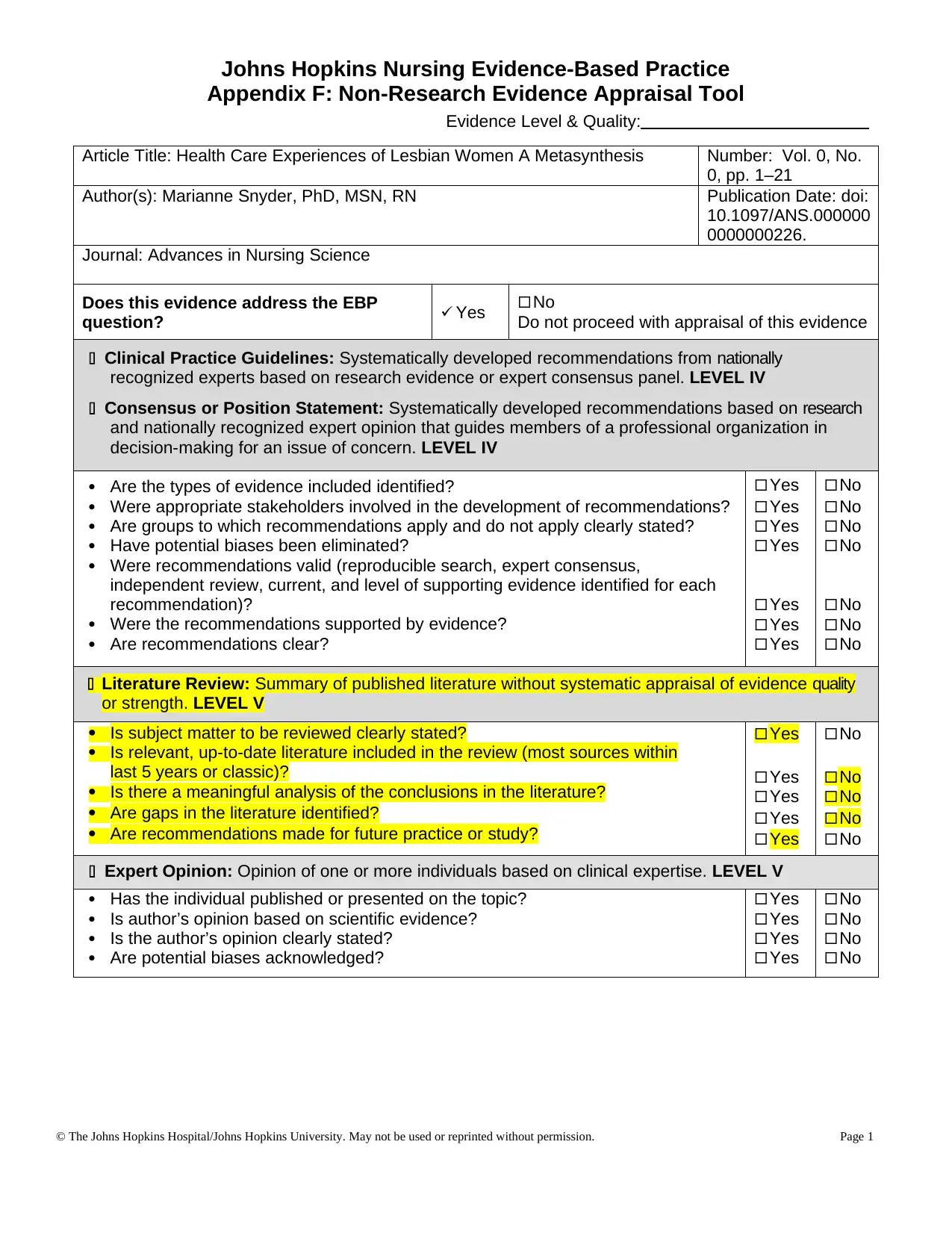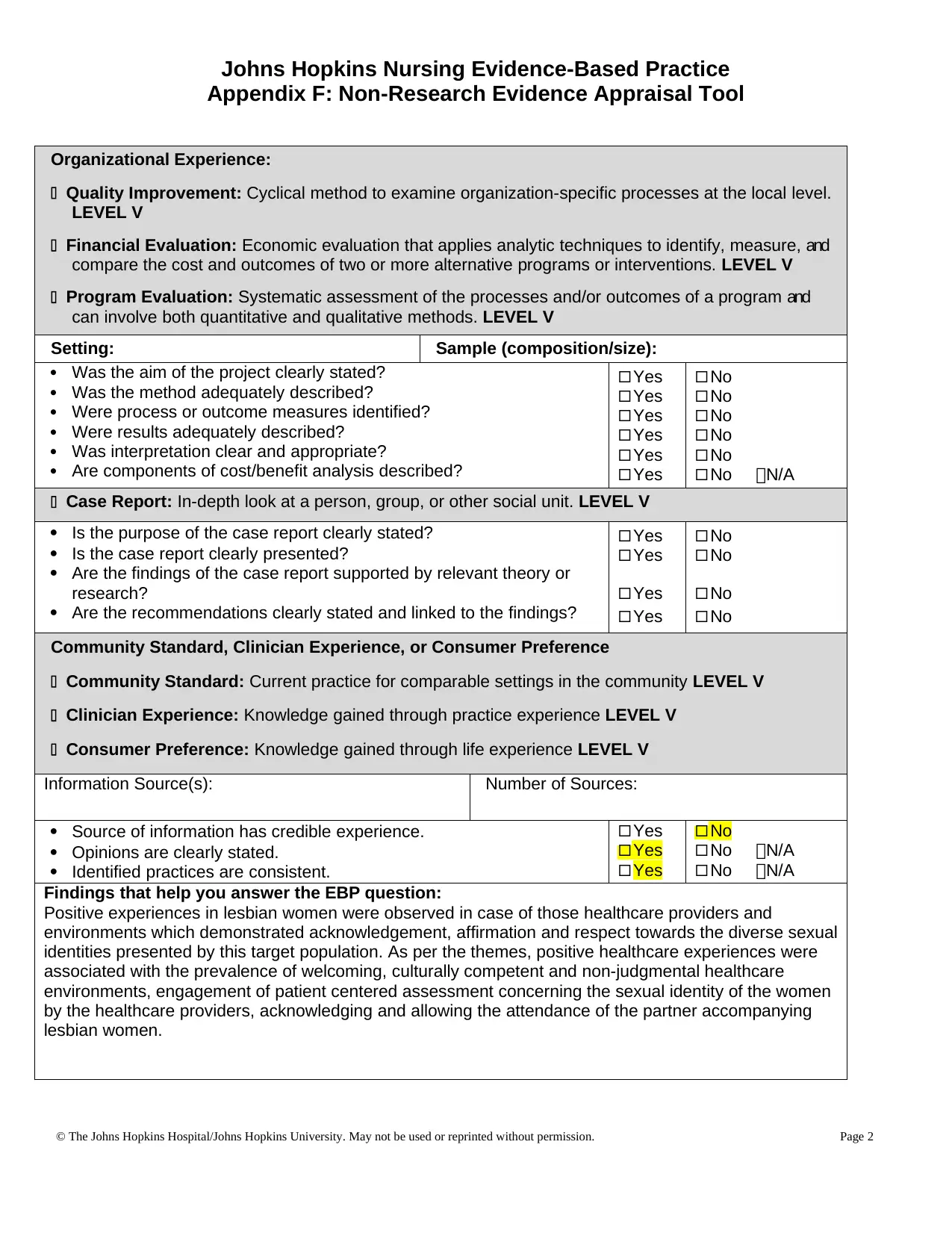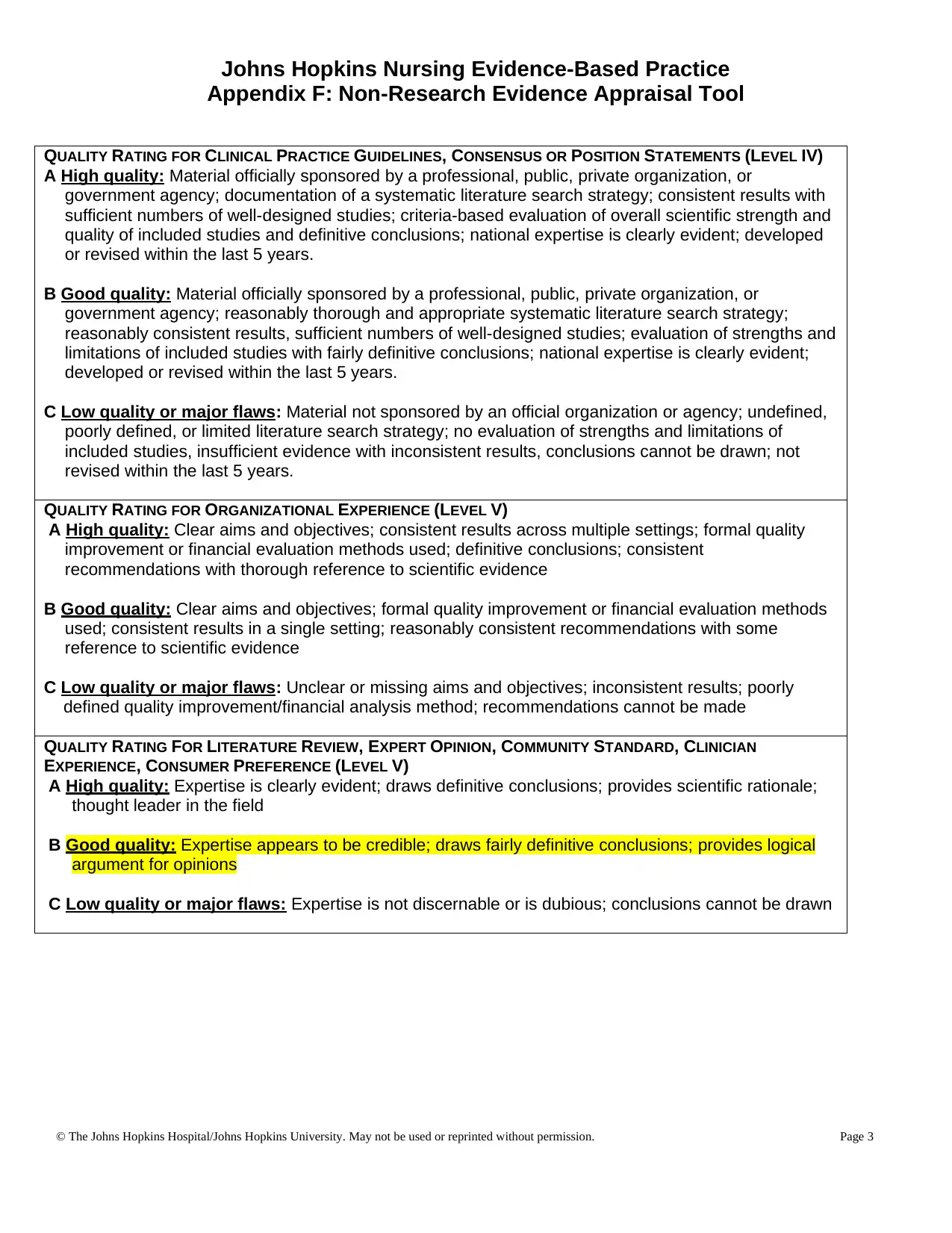Nursing Assignment: Evidence-Based Practice Non-Research Appraisal
VerifiedAdded on 2022/08/19
|3
|1160
|15
Practical Assignment
AI Summary
This assignment requires a critique of a non-research article, specifically focusing on "Health Care Experiences of Lesbian Women: A Metasynthesis" using the Johns Hopkins Nursing Evidence-Based Practice Appraisal Tool. The student is tasked with analyzing the article's topic, focus, and findings. The assignment includes an introduction, ethical review, analysis of findings, limitations, discussion, application to practice, and future implications. The student must also complete the appraisal tool and include it in the appendix, referencing the tool and the chosen article in APA format. The article explores positive healthcare experiences associated with welcoming, culturally competent, and non-judgmental environments, patient-centered assessments, and the inclusion of partners. The critique involves evaluating the evidence level, quality, and application of the findings to nursing practice, emphasizing critical thinking skills for practitioners.

Johns Hopkins Nursing Evidence-Based Practice
Appendix F: Non-Research Evidence Appraisal Tool
© The Johns Hopkins Hospital/Johns Hopkins University. May not be used or reprinted without permission. Page 1
Evidence Level & Quality:
Article Title: Health Care Experiences of Lesbian Women A Metasynthesis Number: Vol. 0, No.
0, pp. 1–21
Author(s): Marianne Snyder, PhD, MSN, RN Publication Date: doi:
10.1097/ANS.000000
0000000226.
Journal: Advances in Nursing Science
Does this evidence address the EBP
question? Yes No
Do not proceed with appraisal of this evidence
◻ Clinical Practice Guidelines: Systematically developed recommendations from nationally
recognized experts based on research evidence or expert consensus panel. LEVEL IV
◻ Consensus or Position Statement: Systematically developed recommendations based on research
and nationally recognized expert opinion that guides members of a professional organization in
decision-making for an issue of concern. LEVEL IV
Are the types of evidence included identified?
Were appropriate stakeholders involved in the development of recommendations?
Are groups to which recommendations apply and do not apply clearly stated?
Have potential biases been eliminated?
Were recommendations valid (reproducible search, expert consensus,
independent review, current, and level of supporting evidence identified for each
recommendation)?
Were the recommendations supported by evidence?
Are recommendations clear?
Yes
Yes
Yes
Yes
Yes
Yes
Yes
No
No
No
No
No
No
No
◻ Literature Review: Summary of published literature without systematic appraisal of evidence quality
or strength. LEVEL V
Is subject matter to be reviewed clearly stated?
Is relevant, up-to-date literature included in the review (most sources within
last 5 years or classic)?
Is there a meaningful analysis of the conclusions in the literature?
Are gaps in the literature identified?
Are recommendations made for future practice or study?
Yes
Yes
Yes
Yes
Yes
No
No
No
No
No
◻ Expert Opinion: Opinion of one or more individuals based on clinical expertise. LEVEL V
Has the individual published or presented on the topic?
Is author’s opinion based on scientific evidence?
Is the author’s opinion clearly stated?
Are potential biases acknowledged?
Yes
Yes
Yes
Yes
No
No
No
No
Appendix F: Non-Research Evidence Appraisal Tool
© The Johns Hopkins Hospital/Johns Hopkins University. May not be used or reprinted without permission. Page 1
Evidence Level & Quality:
Article Title: Health Care Experiences of Lesbian Women A Metasynthesis Number: Vol. 0, No.
0, pp. 1–21
Author(s): Marianne Snyder, PhD, MSN, RN Publication Date: doi:
10.1097/ANS.000000
0000000226.
Journal: Advances in Nursing Science
Does this evidence address the EBP
question? Yes No
Do not proceed with appraisal of this evidence
◻ Clinical Practice Guidelines: Systematically developed recommendations from nationally
recognized experts based on research evidence or expert consensus panel. LEVEL IV
◻ Consensus or Position Statement: Systematically developed recommendations based on research
and nationally recognized expert opinion that guides members of a professional organization in
decision-making for an issue of concern. LEVEL IV
Are the types of evidence included identified?
Were appropriate stakeholders involved in the development of recommendations?
Are groups to which recommendations apply and do not apply clearly stated?
Have potential biases been eliminated?
Were recommendations valid (reproducible search, expert consensus,
independent review, current, and level of supporting evidence identified for each
recommendation)?
Were the recommendations supported by evidence?
Are recommendations clear?
Yes
Yes
Yes
Yes
Yes
Yes
Yes
No
No
No
No
No
No
No
◻ Literature Review: Summary of published literature without systematic appraisal of evidence quality
or strength. LEVEL V
Is subject matter to be reviewed clearly stated?
Is relevant, up-to-date literature included in the review (most sources within
last 5 years or classic)?
Is there a meaningful analysis of the conclusions in the literature?
Are gaps in the literature identified?
Are recommendations made for future practice or study?
Yes
Yes
Yes
Yes
Yes
No
No
No
No
No
◻ Expert Opinion: Opinion of one or more individuals based on clinical expertise. LEVEL V
Has the individual published or presented on the topic?
Is author’s opinion based on scientific evidence?
Is the author’s opinion clearly stated?
Are potential biases acknowledged?
Yes
Yes
Yes
Yes
No
No
No
No
Paraphrase This Document
Need a fresh take? Get an instant paraphrase of this document with our AI Paraphraser

Johns Hopkins Nursing Evidence-Based Practice
Appendix F: Non-Research Evidence Appraisal Tool
© The Johns Hopkins Hospital/Johns Hopkins University. May not be used or reprinted without permission. Page 2
Organizational Experience:
◻ Quality Improvement: Cyclical method to examine organization-specific processes at the local level.
LEVEL V
◻ Financial Evaluation: Economic evaluation that applies analytic techniques to identify, measure, and
compare the cost and outcomes of two or more alternative programs or interventions. LEVEL V
◻ Program Evaluation: Systematic assessment of the processes and/or outcomes of a program and
can involve both quantitative and qualitative methods. LEVEL V
Setting: Sample (composition/size):
Was the aim of the project clearly stated?
Was the method adequately described?
Were process or outcome measures identified?
Were results adequately described?
Was interpretation clear and appropriate?
Are components of cost/benefit analysis described?
Yes
Yes
Yes
Yes
Yes
Yes
No
No
No
No
No
No N/A
◻ Case Report: In-depth look at a person, group, or other social unit. LEVEL V
Is the purpose of the case report clearly stated?
Is the case report clearly presented?
Are the findings of the case report supported by relevant theory or
research?
Are the recommendations clearly stated and linked to the findings?
Yes
Yes
Yes
Yes
No
No
No
No
Community Standard, Clinician Experience, or Consumer Preference
◻ Community Standard: Current practice for comparable settings in the community LEVEL V
◻ Clinician Experience: Knowledge gained through practice experience LEVEL V
◻ Consumer Preference: Knowledge gained through life experience LEVEL V
Information Source(s): Number of Sources:
Source of information has credible experience.
Opinions are clearly stated.
Identified practices are consistent.
Yes
Yes
Yes
No
No N/A
No N/A
Findings that help you answer the EBP question:
Positive experiences in lesbian women were observed in case of those healthcare providers and
environments which demonstrated acknowledgement, affirmation and respect towards the diverse sexual
identities presented by this target population. As per the themes, positive healthcare experiences were
associated with the prevalence of welcoming, culturally competent and non-judgmental healthcare
environments, engagement of patient centered assessment concerning the sexual identity of the women
by the healthcare providers, acknowledging and allowing the attendance of the partner accompanying
lesbian women.
Appendix F: Non-Research Evidence Appraisal Tool
© The Johns Hopkins Hospital/Johns Hopkins University. May not be used or reprinted without permission. Page 2
Organizational Experience:
◻ Quality Improvement: Cyclical method to examine organization-specific processes at the local level.
LEVEL V
◻ Financial Evaluation: Economic evaluation that applies analytic techniques to identify, measure, and
compare the cost and outcomes of two or more alternative programs or interventions. LEVEL V
◻ Program Evaluation: Systematic assessment of the processes and/or outcomes of a program and
can involve both quantitative and qualitative methods. LEVEL V
Setting: Sample (composition/size):
Was the aim of the project clearly stated?
Was the method adequately described?
Were process or outcome measures identified?
Were results adequately described?
Was interpretation clear and appropriate?
Are components of cost/benefit analysis described?
Yes
Yes
Yes
Yes
Yes
Yes
No
No
No
No
No
No N/A
◻ Case Report: In-depth look at a person, group, or other social unit. LEVEL V
Is the purpose of the case report clearly stated?
Is the case report clearly presented?
Are the findings of the case report supported by relevant theory or
research?
Are the recommendations clearly stated and linked to the findings?
Yes
Yes
Yes
Yes
No
No
No
No
Community Standard, Clinician Experience, or Consumer Preference
◻ Community Standard: Current practice for comparable settings in the community LEVEL V
◻ Clinician Experience: Knowledge gained through practice experience LEVEL V
◻ Consumer Preference: Knowledge gained through life experience LEVEL V
Information Source(s): Number of Sources:
Source of information has credible experience.
Opinions are clearly stated.
Identified practices are consistent.
Yes
Yes
Yes
No
No N/A
No N/A
Findings that help you answer the EBP question:
Positive experiences in lesbian women were observed in case of those healthcare providers and
environments which demonstrated acknowledgement, affirmation and respect towards the diverse sexual
identities presented by this target population. As per the themes, positive healthcare experiences were
associated with the prevalence of welcoming, culturally competent and non-judgmental healthcare
environments, engagement of patient centered assessment concerning the sexual identity of the women
by the healthcare providers, acknowledging and allowing the attendance of the partner accompanying
lesbian women.

Johns Hopkins Nursing Evidence-Based Practice
Appendix F: Non-Research Evidence Appraisal Tool
© The Johns Hopkins Hospital/Johns Hopkins University. May not be used or reprinted without permission. Page 3
QUALITY RATING FOR CLINICAL PRACTICE GUIDELINES, CONSENSUS OR POSITION STATEMENTS (LEVEL IV)
A High quality: Material officially sponsored by a professional, public, private organization, or
government agency; documentation of a systematic literature search strategy; consistent results with
sufficient numbers of well-designed studies; criteria-based evaluation of overall scientific strength and
quality of included studies and definitive conclusions; national expertise is clearly evident; developed
or revised within the last 5 years.
B Good quality: Material officially sponsored by a professional, public, private organization, or
government agency; reasonably thorough and appropriate systematic literature search strategy;
reasonably consistent results, sufficient numbers of well-designed studies; evaluation of strengths and
limitations of included studies with fairly definitive conclusions; national expertise is clearly evident;
developed or revised within the last 5 years.
C Low quality or major flaws: Material not sponsored by an official organization or agency; undefined,
poorly defined, or limited literature search strategy; no evaluation of strengths and limitations of
included studies, insufficient evidence with inconsistent results, conclusions cannot be drawn; not
revised within the last 5 years.
QUALITY RATING FOR ORGANIZATIONAL EXPERIENCE (LEVEL V)
A High quality: Clear aims and objectives; consistent results across multiple settings; formal quality
improvement or financial evaluation methods used; definitive conclusions; consistent
recommendations with thorough reference to scientific evidence
B Good quality: Clear aims and objectives; formal quality improvement or financial evaluation methods
used; consistent results in a single setting; reasonably consistent recommendations with some
reference to scientific evidence
C Low quality or major flaws: Unclear or missing aims and objectives; inconsistent results; poorly
defined quality improvement/financial analysis method; recommendations cannot be made
QUALITY RATING FOR LITERATURE REVIEW, EXPERT OPINION, COMMUNITY STANDARD, CLINICIAN
EXPERIENCE, CONSUMER PREFERENCE (LEVEL V)
A High quality: Expertise is clearly evident; draws definitive conclusions; provides scientific rationale;
thought leader in the field
B Good quality: Expertise appears to be credible; draws fairly definitive conclusions; provides logical
argument for opinions
C Low quality or major flaws: Expertise is not discernable or is dubious; conclusions cannot be drawn
Appendix F: Non-Research Evidence Appraisal Tool
© The Johns Hopkins Hospital/Johns Hopkins University. May not be used or reprinted without permission. Page 3
QUALITY RATING FOR CLINICAL PRACTICE GUIDELINES, CONSENSUS OR POSITION STATEMENTS (LEVEL IV)
A High quality: Material officially sponsored by a professional, public, private organization, or
government agency; documentation of a systematic literature search strategy; consistent results with
sufficient numbers of well-designed studies; criteria-based evaluation of overall scientific strength and
quality of included studies and definitive conclusions; national expertise is clearly evident; developed
or revised within the last 5 years.
B Good quality: Material officially sponsored by a professional, public, private organization, or
government agency; reasonably thorough and appropriate systematic literature search strategy;
reasonably consistent results, sufficient numbers of well-designed studies; evaluation of strengths and
limitations of included studies with fairly definitive conclusions; national expertise is clearly evident;
developed or revised within the last 5 years.
C Low quality or major flaws: Material not sponsored by an official organization or agency; undefined,
poorly defined, or limited literature search strategy; no evaluation of strengths and limitations of
included studies, insufficient evidence with inconsistent results, conclusions cannot be drawn; not
revised within the last 5 years.
QUALITY RATING FOR ORGANIZATIONAL EXPERIENCE (LEVEL V)
A High quality: Clear aims and objectives; consistent results across multiple settings; formal quality
improvement or financial evaluation methods used; definitive conclusions; consistent
recommendations with thorough reference to scientific evidence
B Good quality: Clear aims and objectives; formal quality improvement or financial evaluation methods
used; consistent results in a single setting; reasonably consistent recommendations with some
reference to scientific evidence
C Low quality or major flaws: Unclear or missing aims and objectives; inconsistent results; poorly
defined quality improvement/financial analysis method; recommendations cannot be made
QUALITY RATING FOR LITERATURE REVIEW, EXPERT OPINION, COMMUNITY STANDARD, CLINICIAN
EXPERIENCE, CONSUMER PREFERENCE (LEVEL V)
A High quality: Expertise is clearly evident; draws definitive conclusions; provides scientific rationale;
thought leader in the field
B Good quality: Expertise appears to be credible; draws fairly definitive conclusions; provides logical
argument for opinions
C Low quality or major flaws: Expertise is not discernable or is dubious; conclusions cannot be drawn
⊘ This is a preview!⊘
Do you want full access?
Subscribe today to unlock all pages.

Trusted by 1+ million students worldwide
1 out of 3
Related Documents
Your All-in-One AI-Powered Toolkit for Academic Success.
+13062052269
info@desklib.com
Available 24*7 on WhatsApp / Email
![[object Object]](/_next/static/media/star-bottom.7253800d.svg)
Unlock your academic potential
Copyright © 2020–2025 A2Z Services. All Rights Reserved. Developed and managed by ZUCOL.





